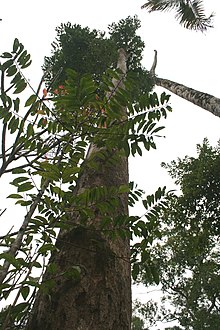
The Sapotaceae are a family of flowering plants belonging to the order Ericales. The family includes about 800 species of evergreen trees and shrubs in around 65 genera. Their distribution is pantropical.

Palaquium is a genus of about 120 species of trees in the family Sapotaceae. Their range is from India across Southeast Asia, Malesia, Papuasia, and Australasia, to the western Pacific Islands.

Manilkara is a genus of trees in the family Sapotaceae. They are widespread in tropical and semitropical locations, in Africa, Madagascar, Asia, Australia, and Latin America, as well as various islands in the Pacific and in the Caribbean. A close relative is the genus Pouteria.

Pouteria is a genus of flowering trees in the gutta-percha family, Sapotaceae. The genus is widespread throughout the tropical Americas, with outlier species in Cameroon and Malesia. It includes the canistel, the mamey sapote, and the lucuma. Commonly, this genus is known as pouteria trees, or in some cases, eggfruits.

Sideroxylon is a genus of trees in the family Sapotaceae described as a genus by Linnaeus in 1753. They are collectively known as bully trees. The generic name is derived from the Greek words σιδηρος (sideros), meaning "iron", and ξύλον (xylon), meaning "wood."

Pleioluma is a genus of flowering plants in the family Sapotaceae. It includes 40 species of evergreen hermaphroditic or gynodioecious trees, reaching up to 25 meters tall.

The Sapotoideae are a subfamily of the flowering plant family Sapotaceae. Plants in the subfamily are characterized by their leather-like leaves, often growing in a stipule fashion.

Planchonella is a genus of flowering trees in the gutta-percha family, Sapotaceae. Named in honour of Jules Émile Planchon, it was described by Jean Baptiste Louis Pierre. It contains around 110 mainly tropical species, which range from Pakistan through Southeast Asia and New Guinea to northern and eastern Australia, New Zealand, and the Pacific Islands. The genus is included in the larger genus Pouteria by some authorities, hence species such as Planchonella australis are also known as Pouteria australis.
Hedyotis (starviolet) is a genus of flowering plants in the family Rubiaceae. Many species of this genus such as Hedyotis biflora, H. corymbosa and H. diffusa are well known medicinal plants. Hedyotis is native to tropical and subtropical Asia and to islands of the northwest Pacific. It comprises about 115 species. The type species for the genus is Hedyotis fruticosa.
Madhuca costulata is a plant in the family Sapotaceae. The specific epithet costulata means "finely ribbed", referring to the leaves.
Madhuca curtisii is a tree in the family Sapotaceae.
Madhuca elmeri is a plant in the family Sapotaceae. It is named for the American botanist and plant collector Adolph Elmer who worked extensively in the Philippines and Borneo.
Madhuca erythrophylla is a plant in the family Sapotaceae. The specific epithet erythrophylla means "red leaves".
Madhuca kingiana is a tree in the family Sapotaceae. It is named for the botanist George King.
Madhuca korthalsii is a tree in the family Sapotaceae. It is named for the Dutch botanist P. W. Korthals.
Madhuca pallida is a tree in the family Sapotaceae. The specific epithet pallida means "pale in colour", referring to the leaves.
Madhuca prolixa is a tree in the family Sapotaceae. The specific epithet prolixa means "expanded", referring to the inflorescences.
Madhuca sarawakensis is a tree in the family Sapotaceae. It grows up to 25 metres (80 ft) tall, with a trunk diameter of up to 35 centimetres (14 in). The bark is greyish. Inflorescences bear up to 10 flowers. The fruits are ellipsoid, up to 3.2 centimetres (1 in) long. The tree is named after Malaysia's Sarawak state. Its habitat is lowland mixed dipterocarp forest from sea level to 50 metres (160 ft) altitude. M. sarawakensis is endemic to Borneo and restricted to Sarawak's Kuching Division.

Hippocratea is a genus of flowering plants in the family Celastraceae, usually lianas, native to tropical and subtropical North America, South America and Africa.








